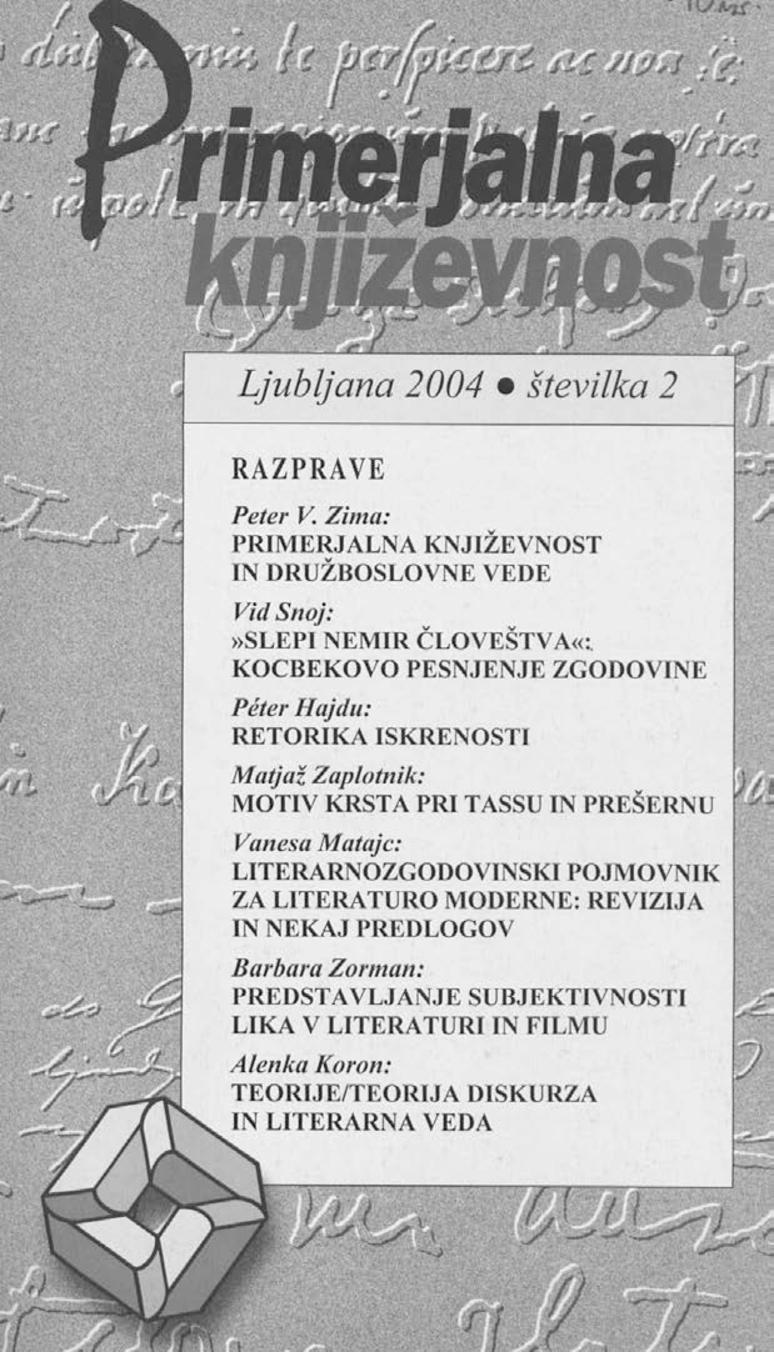Motifs of Baptism in Tasso’s and Prešeren’s Poems
Keywords:
Slovene poetry, Prešeren, France, Italian epic, Tasso, Torquato, literary influences, literary motifs, baptismAbstract
Clorinda’s baptism is one of the main scenes of Tasso’s Gerusalemme liberata. Her conversion has nothing to do with conversions described in chivalric poems. Baptisms described there are briefly mentioned and scarcely make any impact on the character at all. On the other hand, Clorinda’s conversion has independent status in the epic, its description is solemn and profound. This important move towards pietism in Tasso’s epic is important for the distinction between chivalrous/superficial conversion and pietistic/profound conversion. Chivalrous conversion includes strong opposition between “false” faith and “true” faith, while pietistic conversion treats abandoned faith with certain sympathy. – The distinction mentioned above is evident in Prešeren’s poems too: while the baptism mentioned in “Turjaška Rozamunda” has all the characteristics of chivalrous conversion, Črtomir’s baptism in Krst pri Savici is pietistic. Clorinda’s and Črtomir’s baptism take plače at similar locations (a spring of living water and a waterfall). This fact is very important according to the symbolic meaning of water in Christian liturgy. Furthermore, the angelic vision of Clorinda in Tancredi’s dream could have influence on the “rainbow scene” near Savica waterfall in Prešeren’s Krst pri Savici: both scenes include celestial visions of a female character in heavenly glory, having a placid effect on the male character. Adequate passages from both poems are quoted to confirm this thesis. – The final part of this study is dedicated to Bogomila’s conversion, primarily to the dilemma, whether it should be treated as chivalrous or as pietistic conversion. Though Bogomila’s pro-Christian monologue is one of the most religious parts in the poem, the description of her baptism itself is unconvincing and too plain to be considered pietistic. This fact makes Krst pri Savici a paradoxical text. Bogomila’s speech is profound, yet her baptism remains largely superficial, perhaps even ambiguous; on the contrary, the act of Črtomir’s baptism is persuasive, but he alone remains silent.References
BOWRA, C. M., 1948: Tasso and the Romance of Christian Chivalry. From Virgil to Milton. London: MacMillan & Co. 139–193.
CALVI, Bartolomeo, 1959: Fonti italiane e latine nel Prešeren maggiore. Torino: Società editrice internazionale.
COOPER, Henry Ronald, Jr., 1976: »Tasso and Prešeren’s Krst pri Savici.« Papers in Slovene studies. Ur. Rado L. Lenček. 13–23.
FIŠER, Srečko, 2003: »Tasso in Prešeren. Prevajalčeve marginalije in malo literarne zgodovine.« PKn XXVI/2. 21–42.
GANTAR, Kajetan, 1976: »K ’Turjaški Rozamundi’.« JiS IV/7 (1958/59). 200–203.
JAN, Zoltan: »Glasovi o Francetu Prešernu pri Italijanih.« PKn XXIV/2. 53–78.
Katekizem katoliške Cerkve [KKC]. Ljubljana 1993: Slovenska škofovska konferenca.
KIDRIČ, France, 1938: Prešeren II: Biografija 1800–1838. Ljubljana: Tiskovna zadruga.
KOS, Janko, 2002: »Krst pri Savici v luči kritik in interpretacij.« V: Prešeren in krščanstvo. Ljubljana: Slovenska matica. 81–116.
Janko KOS, 1991: »Pesnitev o Črtomiru in Bogomili.« V: Prešeren in njegova doba. Koper: Lipa. 128–142.
KOS, Janko, 1970: Prešeren in evropska romantika. Ljubljana: DZS.
KOS, Janko, 1980: Romantika. Ljubljana: DZS (Literarni leksikon, 6).
MERHAR, Boris, 1961: »Calvijev ’Prešeren’.« Naša sodobnost. 1023–1028, 1141–1150.
NARTNIK, Vlado, 1984/85: »Od ’Povodnega moža’ do ’Turjaške Rozamunde’.« JiS XXX/1–2. 29–31.
PATERNU, Boris, 1977: France Prešeren in njegovo pesniško delo, 2. knjiga. Ljubljana: Mladinska knjiga. 107–145.
Pesem o Rolandu, 1997: Oxfordski rokopis. Prev. Marija Javoršek, spr. beseda Miha Pintarič. Radovljica: Didakta.
PIRJEVEC, Marija, 1992: Na pretoku dveh literatur: Študije in eseji. Trst: Založništvo tržaškega tiska–Narodna in študijska knjižnica. 91–102.
PIRJEVEC, Marija, 2000: »Prešernova pot k Italijanom.« V: Prešernovi dnevi v Kranju: ob 150-letnici smrti dr. Franceta Prešerna. Kranj: MOK. 335–341.
PREŠEREN, France, 1965: Zbrano delo, 1. knjiga. Ur. Janko Kos. Ljubljana: DZS.
PROSENC, Irena, 1998: Elementi čudežnega v Tassovem epu Osvobojeni Jeruzalem. Magistrsko delo. Mentor Atilij Rakar. Univerza v Ljubljani, Filozofska fakulteta, Oddelek za romanske jezike in književnosti.
PROSENC, Irena, 2001: Koncept junaka v italijanskem renesančnem epu konec 15. in v 16. stoletju. Doktorska disertacija. Mentorja Atilij Rakar in Miha Pintarič. Univerza v Ljubljani, Filozofska fakulteta, Oddelek za romanske jezike in književnosti.
SLODNJAK, Anton, 1964: Prešernovo življenje. Ljubljana: Mladinska knjiga.
SLODNJAK, Anton, 1984: France Prešeren. Ur. France Bernik. Ljubljana: Slovenska matica.
SMOLIK, Marijan, 1995: Liturgika: pregled krščanskega bogoslužja. Celje: Mohorjeva družba (Teološki priročniki, 14).
TASSO, Torquato, 1940: La Gerusalemme liberala: E prose scelte. Biografia, introduzione e commento di Claudio Varese. Firence: Vallecchi Editore, 1940. <http://www.liberliber.it/biblioteca/t/tasso/gerusalemme_liberata/html/frames.htm>
TASSO, Torquato, 1977: Osvobojeni Jeruzalem. Odlomek iz XII. speva. Prev. Andrej Capuder. Antologija svetovne književnosti, 2. del. Ljubljana: DZS. 27–29.
VREČKO, Janez, 2002: »Bogomilina vera in Črtomirova mistika.« V: Med antiko in avantgardo. Maribor: Litera. 90–129.


